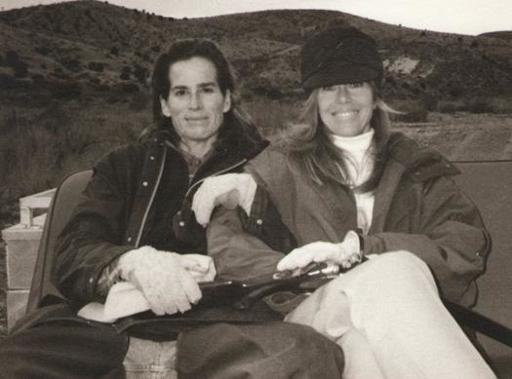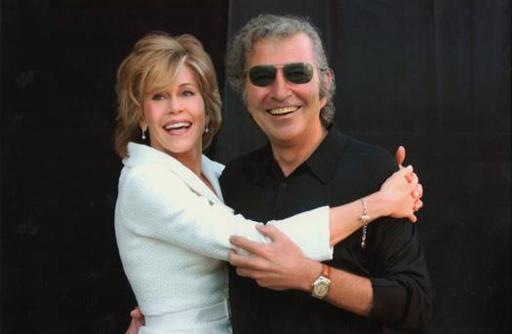Prime Time (28 page)
Authors: Jane Fonda
Tags: #Aging, #Gerontology, #Motion Picture Actors and Actresses - United States, #Social Science, #Rejuvenation, #Aging - Prevention, #Aging - Psychological Aspects, #Motion Picture Actors and Actresses, #General, #Personal Memoirs, #Jane - Health, #Self-Help, #Biography & Autobiography, #Personal Growth, #Fonda

Gloria Steinem visiting me backstage at 33 Variations in Los Angeles in 2011.
All people come into the world as relational beings, but from early on, many if not most men are conditioned to split off from their feelings and find their identity in dominance and independence rather than nurturing and community. I read somewhere that “men especially fear that becoming ‘we’ will erase his ‘I,’ his sense of self.” For most women, their “I” has always been a little porous, whereas women’s “we” has been their saving grace.
What psychologists have discovered since the 1970s is that love and nurturing relationships are at the core of human development. In
Toward a New Psychology of Women,
Dr. Jean Baker Miller writes: “All of living and all of development takes place only within relationships.”
2
The psychologist Carol Gilligan has said that relationships are the “oxygen of the psyche.” Babies die in the absence of attachment. Adults cannot remain stable without outside human contact. All the longitudinal studies on aging show that a key ingredient to doing it successfully is the mutually meaningful giving and receiving of care and nurturing.
In his book
Love and Survival,
Dean Ornish reports that people without loving family, friends, or community are three to five times more likely to die prematurely. Dr. Gene Cohen writes, “Loneliness … is associated with a range of adverse health effects, including slower recovery from coronary artery bypass surgery, more office visits to physicians, poorer dental health, and a greater likelihood of nursing home admission. Thus the positive impact of social networks on the health of the mind, body, and brain in late life can be profound.”
3
A University of Michigan study reports that feeling close to someone increases one’s level of the hormone progesterone, which helps boost the sense of well-being and reduces stress and anxiety. This hormone is also linked to a desire to help others, even at one’s own expense.
Kissing my grandson, Malcolm.
DONNA FERRATO 2001
The social neuroscientist John Cacioppo is a distinguished service professor at the University of Chicago. He studies the stress of loneliness on our bodies and on our minds. As a guest on NPR’s
The Diane Rehm Show,
Mr. Cacioppo said, “Loneliness is the perception that you are isolated from others. It’s not the reality of being isolated. In fact, studies have shown it is not the frequency of contact with other people, it is not whether you are alone or not; we actually did such a study and found lonely and non-lonely individuals spent the same amount of time with other people.… It’s a perception that you’re isolated. People can be isolated in a marriage, with friends, being the last one chosen on a team. You’re a member of that team and yet somehow you don’t feel a part of it. So loneliness is this perception.”
4
This made me think about the many months I spent essentially alone writing
My Life So Far,
and my solitude right now as I write this book. I’ve never felt alone at such times, and I think it is because I write to communicate with people, and so I am always thinking about those people out there who will read my book, and this makes my aloneness a very non-isolated time. Solitude is not loneliness. I have also found that praying or meditating can alleviate feelings of loneliness because they are a form of being connected to something greater than ourselves.
Loneliness can become more of a problem in the Third Act. Friends and family may have died; disability may prevent us from going out and interacting the way we used to. The physiological impact of loneliness—stress, lowered immune system, anxiety, and depression, along with the challenges I already mentioned—make it important for older people to summon the effort to reach out by phone, over the Internet, by joining a club or going to a senior center. Try putting yourself into situations where you’re likely to find people who share your interests, your values—or your challenges. I have talked to a number of women who met new friends while attending a grief management program for women who had lost their husbands. In his book about longevity,
The Blue Zone,
Dan Buettner suggests joining a spiritual community; if you aren’t of a particular denomination, you might try humanistic communities like the American Ethical Union or Unitarian Universalism. Volunteering is a win-win: You simultaneously meet new people while doing good. One important thing I’ve learned over the decades is that when seeking a relationship, it can be more important to be interested than to be interesting.
As Mr. Cacioppo says, “One doesn’t have to connect with ten thousand friends. Just connecting in a minor way with someone who you are not going to interact with again, perhaps a taxi driver; just a moment of being nice to another person and having them be nice in return can be the beginning of reconnection.… But you want to extend yourself in a safe environment, because underlying the misery of loneliness is this feeling of threatened fear. And so you want to be in a safe place. Don’t try to hit a home run with the first social contact. Be satisfied with little steps initially.”
On the set of
Monster-in Law
with my assistant, Steven Bennett (on the right), and his partner, the artist Chester Old.
Now, dogs are great for companionship; don’t get me wrong. In fact, their unconditional love boosts our oxytocin levels and can even cause us to live longer. Reports have shown that “dog-owning cardiac patients die at one-quarter to one-sixth the rate of those who forgo canine companionship.” Shirley MacLaine says, “Older people should have dogs. It helps us to go into hyperlove, and love is what ageing is all about.”
5
Dogs are easy. People less so. But all our developmental stumbling blocks stem from relationships with
people.
Turning the stumbling blocks into building blocks of
people
relationships—these are the crucibles in which we can grow.
Two centenarians I met in Atlanta were perfect examples of the kind of attitude that feeds relationships as well as longevity. Ben Burke was 101 years old in 2008 when I met him and “still percolating,” as he put it. He takes care of himself and cooks all his own meals, and, I’m told, everyone in his ten-floor, three-hundred-unit condominium building knows him, and he’s making an effort to get to know all of them on a first-name basis. Ben also has a passion for making music with his banjo—not just playing it but sharing it with people in his building. “Just brightening them up,” he says. “Upstairs is an assisted living department where I go with a couple of musicians, whoever is available, and we play ‘golden oldies.’ ” I discovered that Ben has a woman friend up there, which gives him added incentive—but more about that in the chapter on sex!
With pal Robin Laughlin.
Ben didn’t start playing the banjo until he was seventy-two. That was when he persuaded his son to resurrect the Tuneagers, a band he’d started as a teenager, so they could play together. “Making music and brightening up people are the lifeline to my living,” Ben tells me. “There’s gotta be more to life than food and shelter and being a beach bum.”
Ben’s wife of fifty-eight and a half years died from complications from Alzheimer’s disease on Christmas Day in 1997. “I figured I had to do something to keep me living, and that was music,” he says. “So you see what music has meant to me. You had mentioned that the later part of your life can be the best part of it. You got that right! Not for everybody, but for me, fortunately.”
Like Ben, 104-year-old Rachel Lehman devotes her life to keeping busy and brightening people’s lives. A friend who’s known Rachel for a long time told me this about her. It’s a recipe for a long, healthy life: “One of the things so remarkable about Rachel is that she’s rarely self-absorbed. I have yet to see her when she’s not asking about me and my family. That quality has made her a magnet. She draws people to her, and they love her. It keeps her connected to lots of different kinds of people of different ages.”
The day I met Rachel she walked slowly into the reception room of an assisted living complex using a walker, helped by her daughter and the friend, but she had a twinkle in her eye. “You know, Jane, we met before, at your Workout Studio in Beverly Hills in the 1970s.” “We did!” I exclaimed. “How old were you?” “Musta been in my seventies. My niece Didi Conn brought me. We did one of those classes together.”
Around that same time, Rachel had moved to Atlanta and answered a newspaper ad for a volunteer position with the Atlanta Opera. She got the job and still works there every week as a fund-raiser. She also has a singing group called the Georgia Classic Club. “You have to be sixty to join,” she pointed out with a wink.
“What do you sing?” I asked.
“ ‘Second Hand Rose’ is my specialty number,” she replied and promptly got up and, using a cane, did a slow soft-shoe while singing a few verses.
When Rachel was 101, she read in the sports section of the
Atlanta Journal-Constitution
about a bowler named Bill Hargrove who was 102. She called the paper, got his phone number, and called him. They subsequently became friends, and for her 102nd-birthday party he brought her three long-stemmed red roses. She confided to the Atlanta paper that he’d said to her, “I came in here looking for an old lady, but I can’t find one.” When the paper called to let her know Bill had died (he was about to turn 107), she reminisced with the reporter about the fun times they’d had. “He would tell me, ‘When I go to bed at night I see you in my dreams!’ How can you top that?” She’d brought Bill a bottle of wine for his 106th-birthday party, in 2007. “I mean at our age, why not?” she told the paper. “We always had so much fun together. I just wish we could have started a little earlier. But I’m so happy I got to meet him. He was so handsome!” She planned to attend his memorial service bearing three long-stemmed roses.
I asked Rachel the secret to her joie de vivre. “There is no secret, really,” she replied, “but I find that if you smile at somebody who comes home with a sourpuss, if you just put a big smile on your face, you know, it manufactures into the next person. It causes an epidemic of love.”
Maybe we can’t all cause an epidemic of love, but putting on a smile and showing an interest in others is bound to draw them to us. Making an effort to play the hand of friendship in our Third Acts will serve us well.




